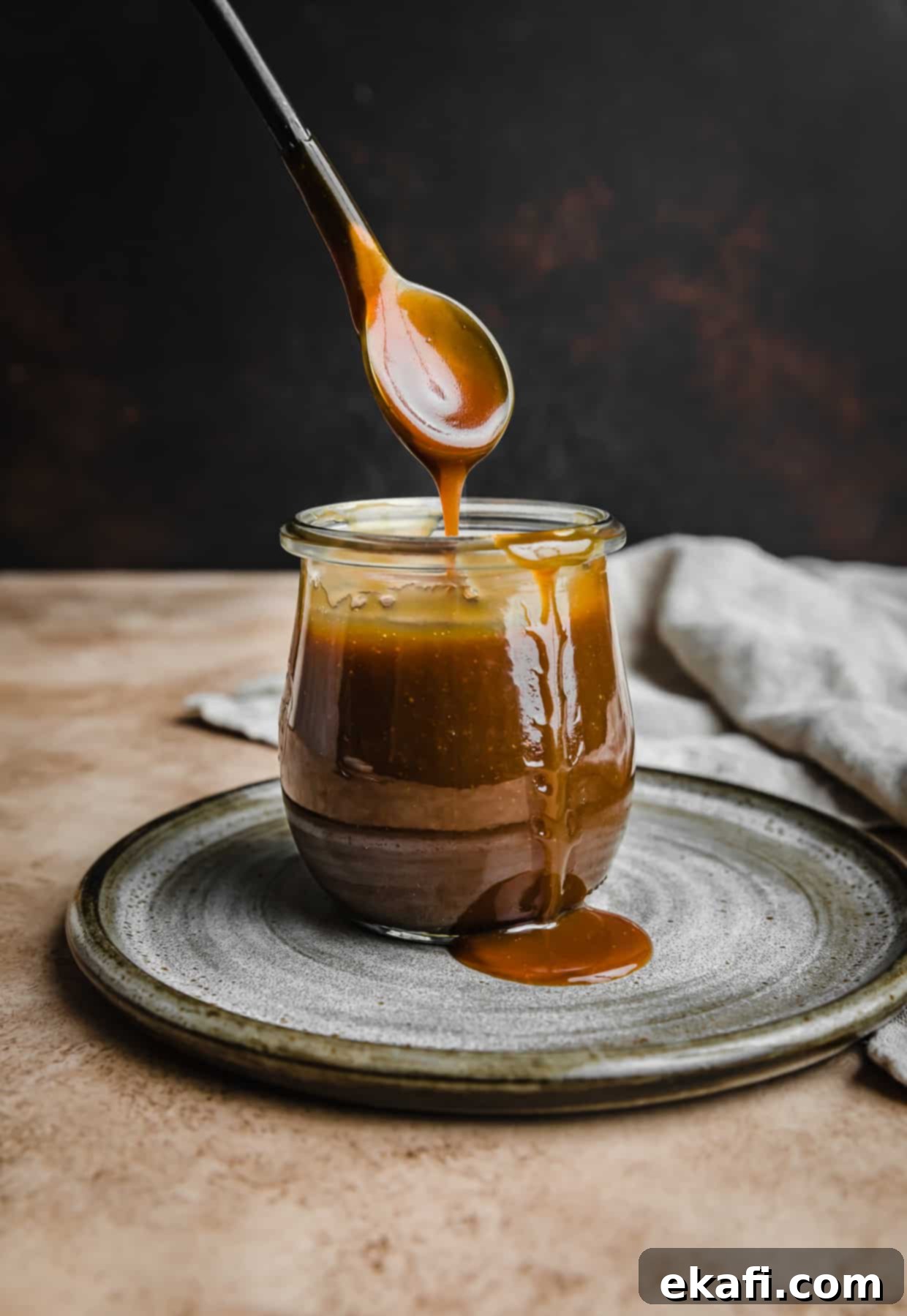Irresistible Homemade Salted Butterscotch Sauce: Your New Favorite Decadent Dessert Topping
Prepare to elevate your dessert game with this truly irresistible Salted Butterscotch Sauce! Incredibly rich, perfectly thick, and unbelievably smooth, this decadent sauce is ready in just 10 minutes with only 5 simple ingredients. Whether you’re a long-time butterscotch enthusiast or just discovering its golden charm, this easy homemade recipe is guaranteed to become a staple in your kitchen. It’s the ultimate complement to nearly any sweet treat, transforming ordinary desserts into extraordinary culinary experiences.
I confess, I’m absolutely captivated by the unique flavor of butterscotch. There’s something about that deep, caramelized brown sugar and buttery essence that truly hits the spot. That’s why I felt compelled to create a butterscotch sauce recipe that’s not only simple to make but also delivers on intense flavor. If you’re as smitten with butterscotch as I am, be sure to explore more delightful recipes, such as my Butterscotch Oatmeal Cookies and Creamy Butterscotch Ice Cream, for an even deeper dive into this wonderful flavor!
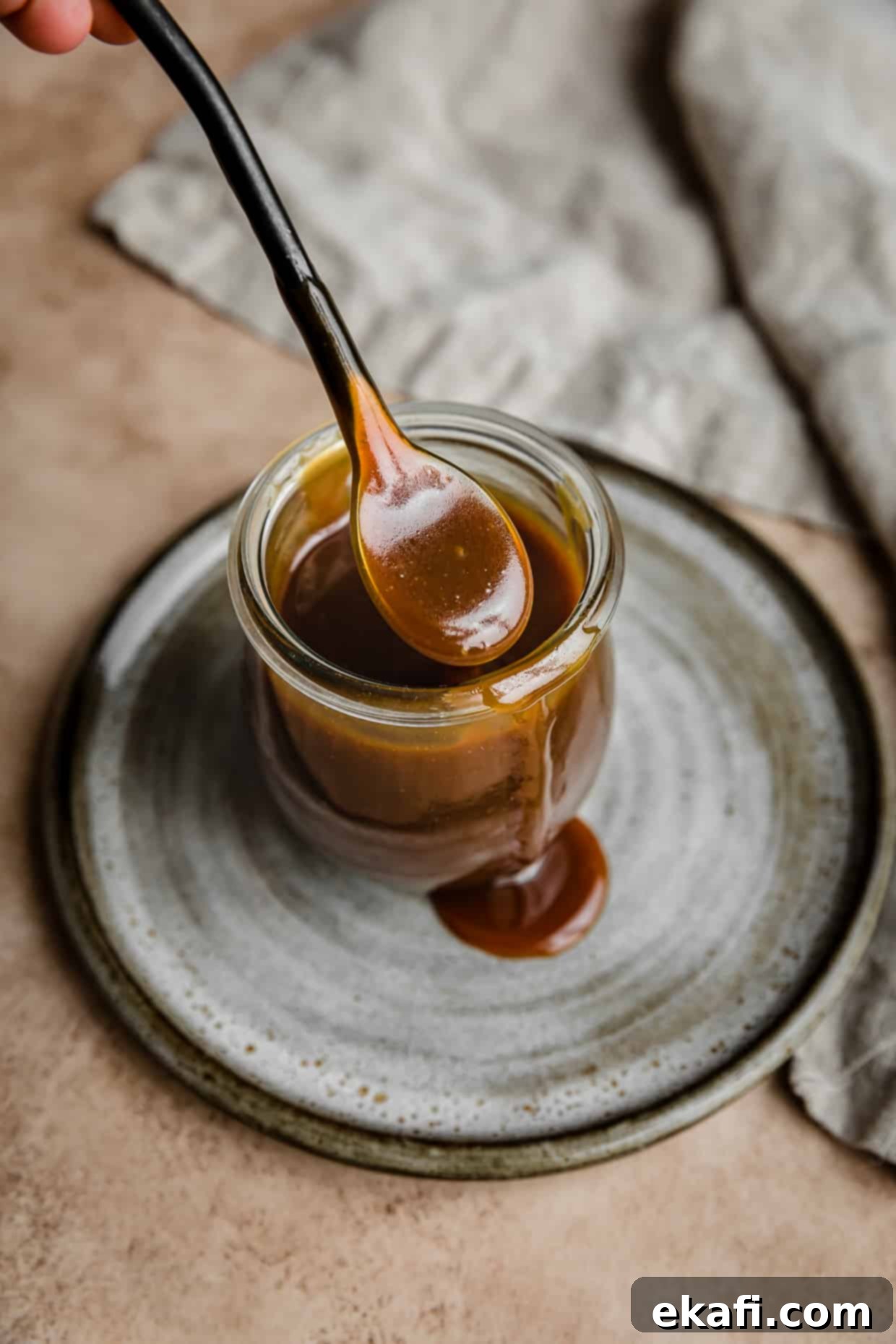
Why This Homemade Butterscotch Sauce Recipe Is a Must-Try
If you’re looking for a homemade dessert topping that’s both simple and spectacular, this salted butterscotch sauce is your answer. Here’s why this recipe stands out and quickly becomes a favorite:
- Effortlessly Simple Ingredients: This recipe champions simplicity! You’ll be delighted to find that all the essential components – butter, brown sugar, salt, heavy cream, and vanilla extract – are likely already waiting in your pantry. There’s no need for obscure or hard-to-find items, making this the best butterscotch sauce for spontaneous cravings or last-minute dessert preparations. It’s truly amazing how such a straightforward combination yields such a rich and decadent result.
- Remarkably Quick to Prepare: Time is precious, and this easy butterscotch sauce respects that. From start to finish, you can whip up a batch of this luscious sauce in just 10 minutes! This means you can have a warm, velvety topping ready before your ice cream even starts to melt. It’s the perfect solution when you desire a gourmet touch without spending hours in the kitchen.
- The Ultimate Dessert Enhancer: The versatility of this salted butterscotch sauce is unmatched. It’s designed to be the perfect complement to an endless array of desserts. Imagine drizzling its warm, golden goodness over your favorite fudgy brownies, fluffy cakes, chewy cookies, or flaky pies. It’s an absolute dream topping for vanilla or chocolate ice cream, an essential component for any ice cream sundae, or even a delightful dip for fresh fruit. Honestly, it’s so good you might even find yourself enjoying it by the spoonful straight from the jar – no judgment here! The possibilities for indulgence are truly limitless.
Essential Ingredient Breakdown for Perfect Butterscotch
Crafting the perfect butterscotch sauce starts with understanding each ingredient and its role. While this recipe uses minimal ingredients, the quality and type can significantly impact the final flavor and texture. Here’s a detailed look at what you’ll need:
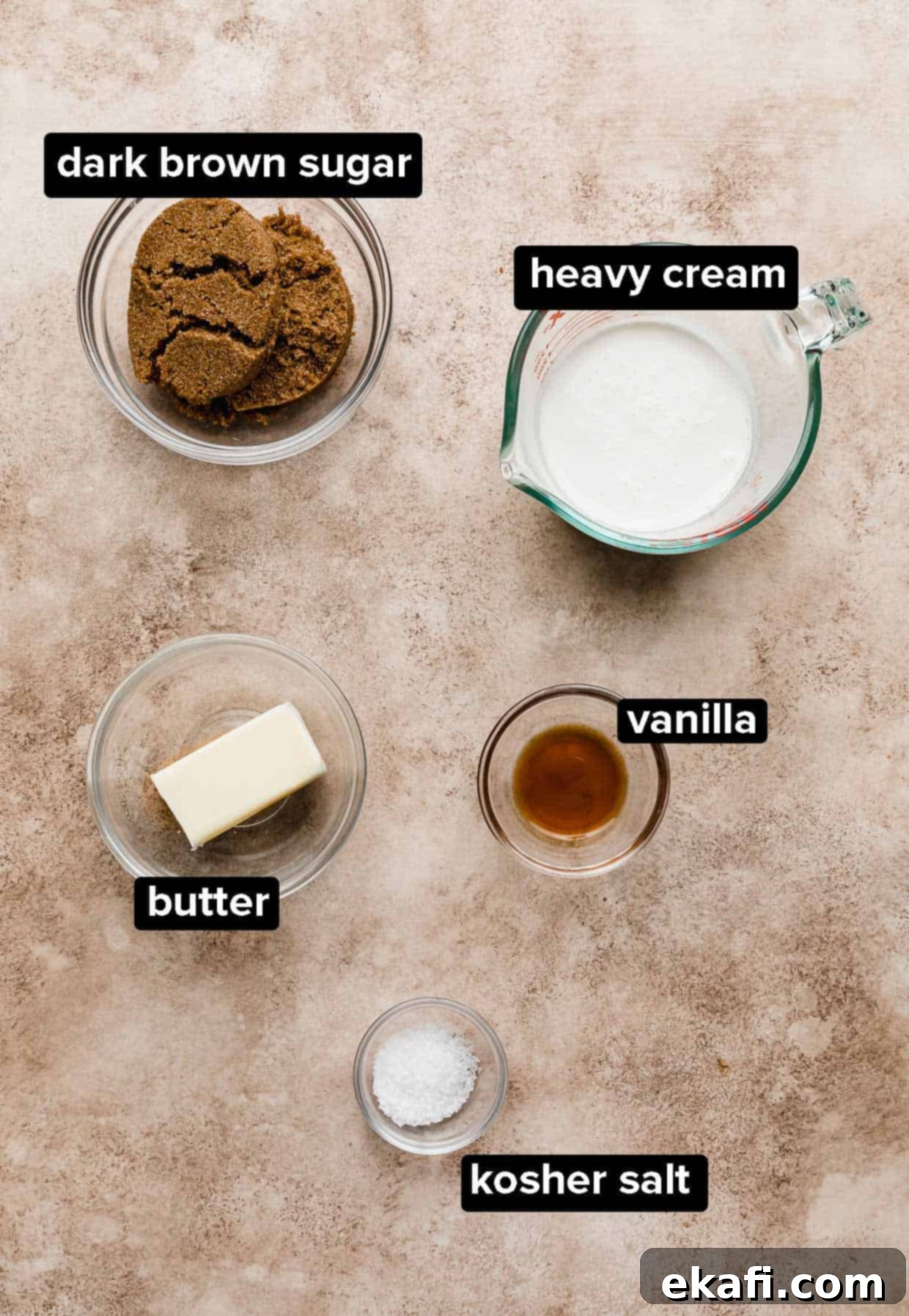
- Unsalted Butter: Butter is the foundation of butterscotch, providing its characteristic rich, creamy flavor and smooth texture. Using unsalted butter gives you complete control over the salt content in your sauce, which is particularly important for a “salted” butterscotch recipe. If you only have salted butter on hand, you can absolutely use it! Just be sure to reduce the amount of added kosher salt in the recipe by approximately 1/4 teaspoon for every 1/2 cup of salted butter used to maintain the perfect balance.
- Brown Sugar: This is the defining ingredient of butterscotch, distinguishing it from caramel. I highly recommend using dark brown sugar for this recipe. Dark brown sugar contains more molasses than light brown sugar, which results in a deeper, more complex, and richer caramel-like flavor, as well as a beautiful, darker golden hue for your sauce. While light brown sugar can be used, expect a slightly milder flavor and lighter color.
- Kosher Salt: A pinch of salt is crucial for balancing the sweetness and enhancing the deep flavors of the butterscotch. Kosher salt is preferred for its coarser texture and pure flavor compared to regular table salt. It dissolves nicely and evenly in the sauce. When substituting, remember that kosher salt is less dense than table salt. If a recipe calls for Kosher salt, use about 1/4 teaspoon less of fine table salt per teaspoon. Conversely, if a recipe specifies table salt, use 1/4 teaspoon more of Kosher salt per teaspoon to achieve similar saltiness.
- Heavy Cream: This ingredient is essential for achieving the luxurious, creamy texture that defines a great butterscotch sauce. Heavy cream, with its high-fat content, contributes significantly to the richness and helps emulsify the butter and sugar, preventing separation. As the mixture heats and cools, the heavy cream helps the sauce thicken beautifully, giving it that perfect pourable consistency. Do not substitute with lighter creams or milk, as they won’t provide the same richness or thickening power.
- Vanilla Extract: Added at the very end, vanilla extract brightens and rounds out all the flavors, adding a warm, aromatic depth that complements the butterscotch beautifully. While a small amount, it makes a big difference in the overall complexity of the sauce. Use a good quality pure vanilla extract for the best results.
Effortless Step-by-Step Guide to Homemade Butterscotch Sauce
Creating this rich and smooth salted butterscotch sauce is incredibly straightforward. Follow these simple steps for a perfect batch every time:
- Melt the Butter: Begin by adding the specified amount of butter to a medium saucepan. Place the saucepan over medium heat and allow the butter to gently melt completely. Keep a close eye on it to prevent burning.
- Combine Main Ingredients (Except Vanilla): Once the butter is fully melted, add the brown sugar, kosher salt, and heavy cream to the saucepan. Using a rubber spatula or a wooden spoon, stir the mixture consistently until all the ingredients are thoroughly combined and the sugar begins to dissolve into the butter and cream. This initial stirring is crucial for a smooth base.
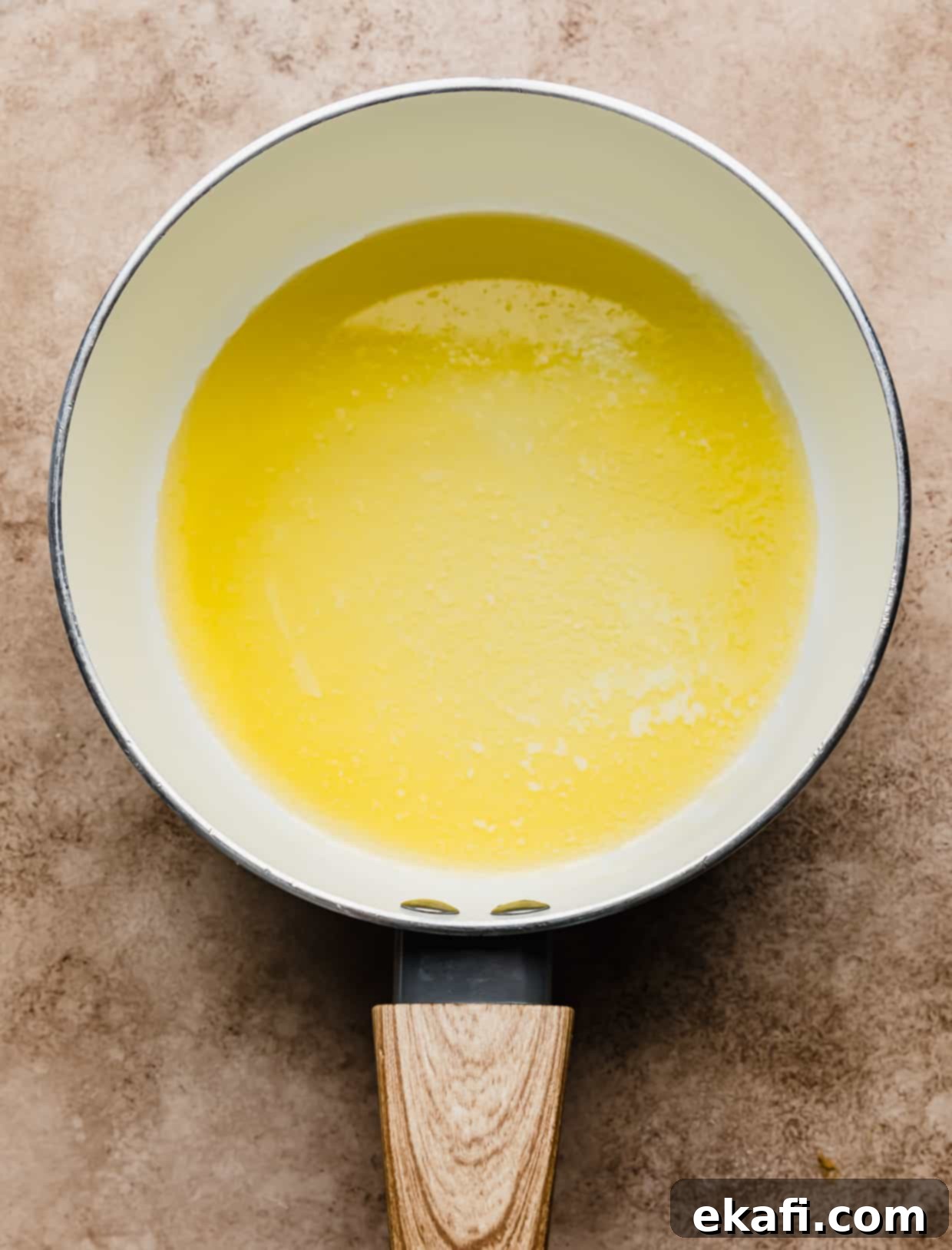
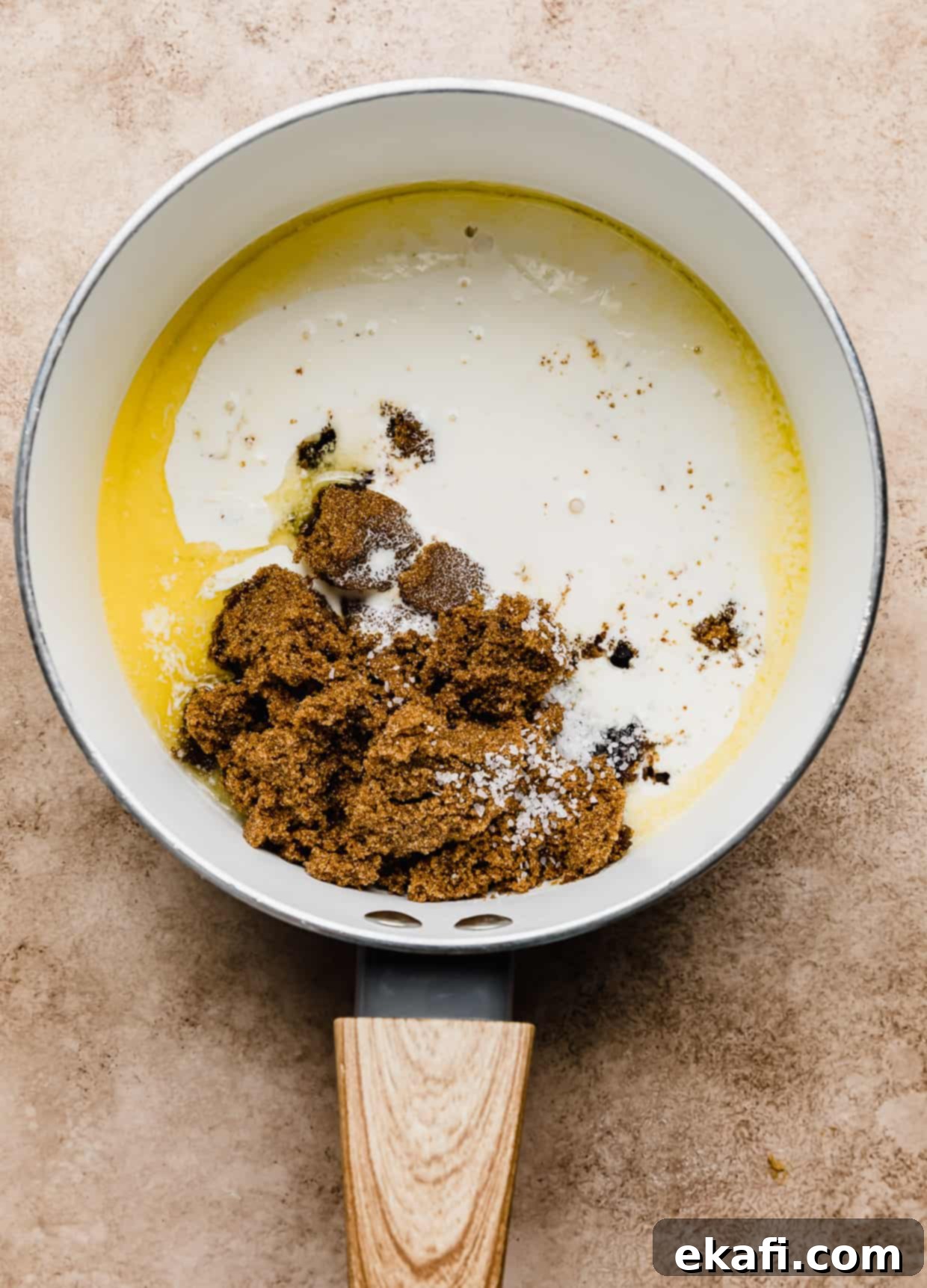
- Bring to a Gentle Boil: Increase the heat slightly if needed to bring the butterscotch mixture to a gentle boil. Once boiling, reduce the heat to maintain a steady simmer and continue to boil for 4-5 minutes. Stir occasionally during this time to prevent sticking and ensure even cooking and thickening. This boiling period is essential for dissolving the sugar and developing the rich butterscotch flavor.
- Add Vanilla Extract: After the boiling time, immediately remove the pan from the heat. This stops the cooking process and prevents the sauce from becoming too thick. Stir in the vanilla extract vigorously until it is fully incorporated. The warmth of the sauce will help the vanilla release its full aroma and flavor.
- Cool and Thicken: Allow the homemade butterscotch sauce to rest in the saucepan for a minute or two. Then, carefully transfer the warm sauce to a heat-proof container, such as a glass jar. As the sauce cools, it will continue to thicken considerably, reaching that perfect pourable consistency. Serve your decadent butterscotch warm or at room temperature, depending on your preference and the dessert you’re pairing it with.
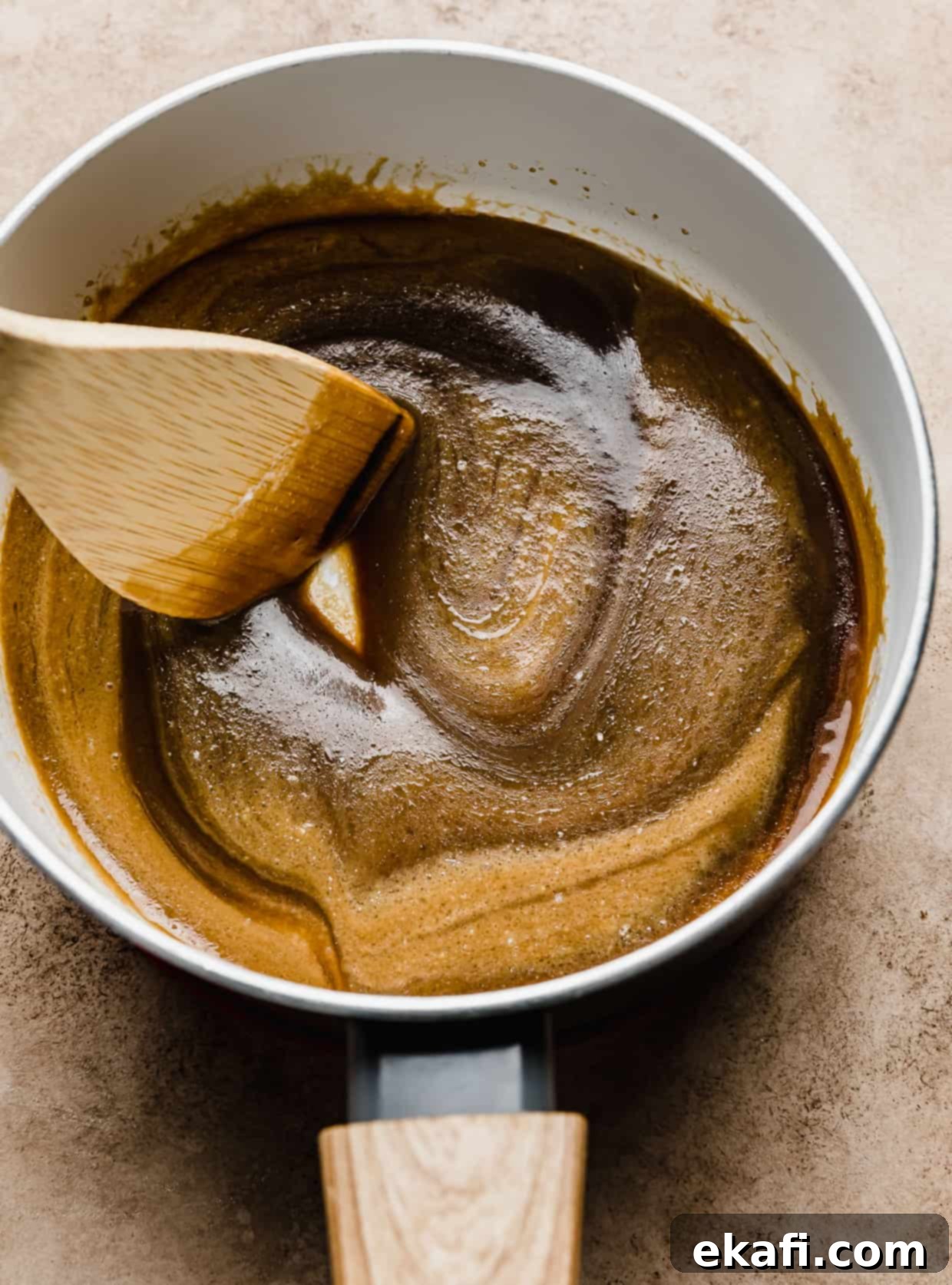
Expert Tips for the Best Homemade Salted Butterscotch Sauce
Achieving butterscotch perfection is easy with a few insider tips. Keep these pointers in mind for a consistently delicious and foolproof sauce every time:
- Optimal Serving Suggestions: This incredibly versatile homemade butterscotch sauce pairs beautifully with so many treats! Beyond the usual suspects, try it generously drizzled over Homemade Vanilla Ice Cream, spread onto an Ice Cream Cake Roll, or spooned over warm cakes, fudgy brownies, and chewy cookies. It’s also fantastic on pancakes, waffles, peach cobbler, or even mixed into a delightful butterscotch milkshake! Get creative and enjoy this luscious topping.
- Preventing Sauce Separation: To ensure your butterscotch sauce remains beautifully emulsified and smooth, be mindful of your stirring technique. Avoid over-stirring while the brown sugar is melting and during the initial boil. Constant, aggressive stirring can sometimes cause the butter and sugar to separate. Additionally, allow the sauce to cool slowly and gradually. Abrupt temperature shifts can increase the risk of separation, so resist the urge to rapidly chill it.
- Combating Crystallization: While this recipe is designed to minimize crystallization, it can sometimes occur, especially in humid conditions. If you’ve ever experienced grainy or sugary butterscotch, a simple trick is to add 1/4 teaspoon of lemon juice to the saucepan at the same time you add the brown sugar. The acidity of the lemon juice helps break down the sugar molecules, preventing them from reforming into crystals. Don’t worry, such a small amount won’t alter the delicious butterscotch flavor!
- Choosing Your Brown Sugar: As mentioned in the ingredient notes, both light and dark brown sugar can be used. However, for a truly rich, deep, and robust butterscotch flavor with a beautiful, darker amber color, I highly recommend opting for dark brown sugar. Its higher molasses content delivers that quintessential decadent taste.
- Achieving Perfect Thickness – Don’t Over-Boil!: This is a crucial tip for perfect butterscotch sauce. The mixture will thicken considerably as it cools. Therefore, it’s vital not to over-boil the sauce. Stick to the recommended 4-5 minutes of boiling time. If you boil it for too long, the sauce will become excessively thick – perhaps even candy-like – and lose its desirable pourable consistency. After the specified boiling time, remove it from the heat and trust that it will reach its ideal thickness as it cools.
- Maintain Moderate Heat: Throughout the cooking process, keep the heat at a moderate level. While you need enough heat to melt the butter and dissolve the sugar, excessively high heat can cause the sugar to burn quickly, leading to a bitter taste and potential scorching. A moderate temperature ensures the sugar dissolves gently and caramelizes evenly, developing complex flavors without burning.
- Storage Solution: For convenient storage and a charming presentation, consider pouring your finished butterscotch sauce into mini glass jars. These are perfect for gifting or for keeping small portions readily available in your fridge.
Make Ahead, Storing, and Freezing Your Butterscotch Sauce
This homemade salted butterscotch sauce is fantastic for making ahead, ensuring you always have a delightful topping on hand. Here’s how to properly store it:
- Storage: Once cooled, transfer the butterscotch sauce to an airtight container. Store it in the refrigerator, where it will remain fresh and delicious for up to 2 weeks. Its thick consistency makes it easy to portion out whenever a craving strikes.
- Reheating: To reheat, simply place the desired amount of sauce in a microwave-safe container and warm it in 10-15 second increments, stirring between each interval, until it reaches your desired warm, pourable consistency. Alternatively, you can gently reheat it in a small saucepan over low heat, stirring constantly. Avoid drastic or rapid heating, as this can sometimes cause the sauce to separate or develop a grainy texture.
- Freezing (Not Recommended): While many things can be frozen, I strongly advise against freezing this homemade salted butterscotch sauce. The heavy cream, a key ingredient, has a tendency to separate once frozen and then thawed. This can result in an unappealing grainy, watery, or curdled texture. Given that this delicious recipe only takes 10 minutes to prepare, it’s far better to enjoy it fresh. If you need to prepare it in advance, simply make it within the two-week refrigerated storage window.
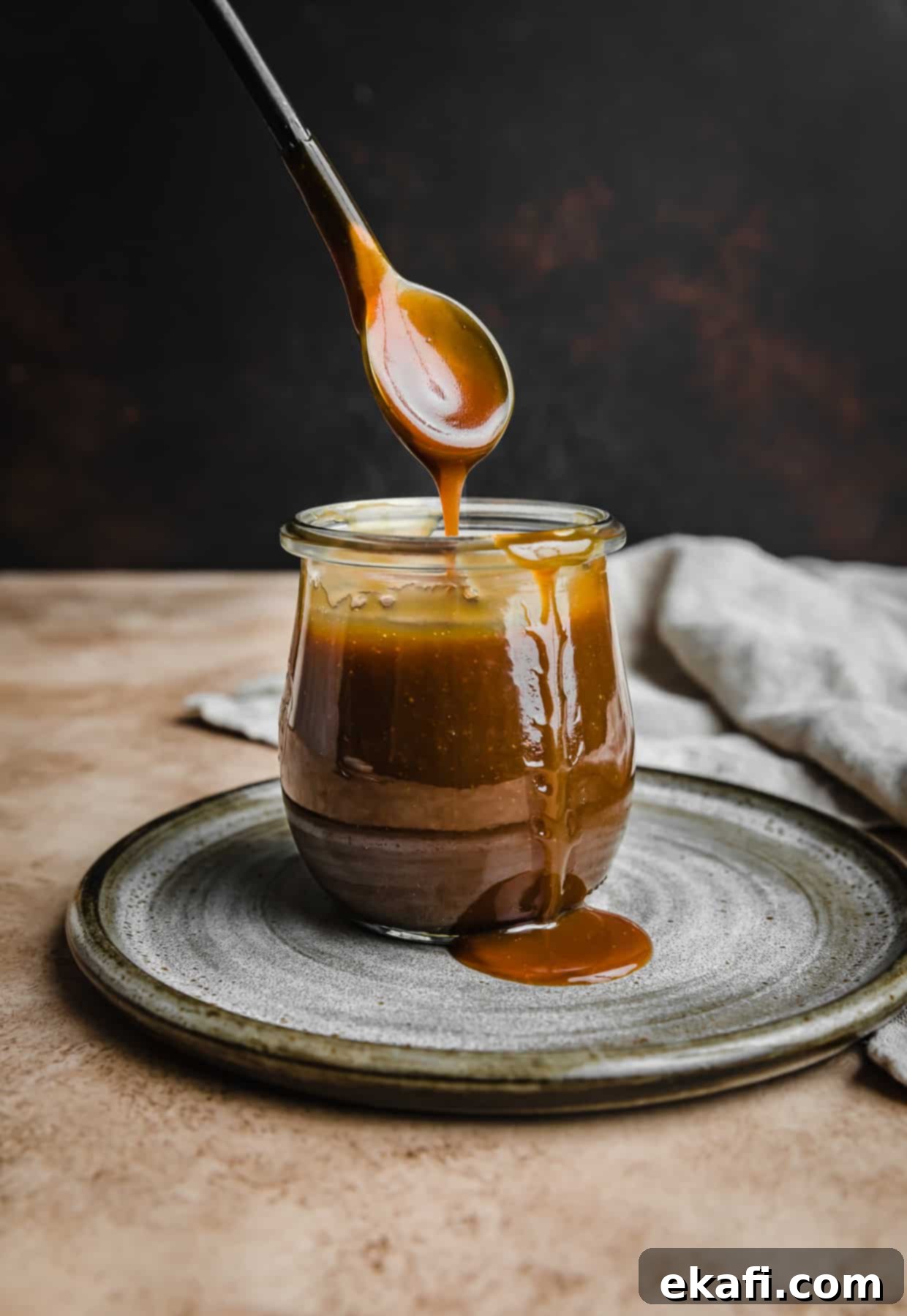
Frequently Asked Questions About Butterscotch Sauce
Here are some common questions about butterscotch sauce, its ingredients, and how to best enjoy it:
Classic butterscotch sauce is primarily made from a simple yet magical combination of brown sugar, butter, heavy cream, and vanilla extract. The brown sugar is key, giving butterscotch its distinctive deep, caramelized flavor profile that sets it apart from other sweet sauces. A touch of salt is also often added to enhance and balance the sweetness, creating a truly irresistible flavor.
The fundamental difference between butterscotch and caramel lies in their sugar base. Caramel is traditionally made using granulated white sugar, which is cooked until it caramelizes and develops its signature amber color and nutty flavor. Butterscotch, on the other hand, exclusively uses brown sugar, imparting a richer, more molasses-like depth from the start. Additionally, butter is always a crucial ingredient in butterscotch, contributing to its name and flavor, whereas traditional caramel recipes don’t always include butter and often feature corn syrup to prevent crystallization.
If a recipe calls for butterscotch and you don’t have any, the closest substitute is caramel sauce. Both sauces share a similar creamy, sweet profile and are typically used in similar ways as dessert toppings or flavorings. While caramel also provides a rich, sweet, and slightly caramelized flavor, remember that it’s usually made with white granulated sugar, giving it a slightly different, often less molasses-rich taste than butterscotch’s brown sugar base. For best results, use a high-quality homemade or store-bought caramel.
Butterscotch sauce is incredibly versatile and pairs wonderfully with almost any dessert! It’s absolutely delicious drizzled over warm brownies, spooned onto vanilla or chocolate ice cream, used as a filling for cakes, or as a dip for apple slices. You can also incorporate it into milkshakes, sundaes, peach cobbler, or even enjoy it with warm bread pudding. Its rich, buttery, and sweet flavor complements a wide range of sweet treats, making it a go-to topping for countless occasions.
It is generally not recommended to freeze homemade butterscotch sauce. The heavy cream in the sauce is prone to separating and changing texture when frozen and then thawed. This can result in a grainy, watery, or otherwise unpleasant consistency, detracting from the smooth, luscious texture you expect. Since this recipe is quick to make and stores well in the refrigerator, it’s best to prepare it fresh or make it ahead and store it chilled.
Yes, butterscotch sauce can be easily reheated. The key is to do it gently and slowly to maintain its smooth texture. For small amounts, place the sauce in a microwave-safe container and heat it in short bursts of 10-15 seconds, stirring well after each interval, until it’s warm and pourable. Alternatively, you can reheat it on the stovetop over very low heat, stirring constantly until it reaches the desired temperature. Avoid overheating or drastic temperature changes, as this can cause the sauce to separate or become grainy.
Yes, homemade butterscotch sauce absolutely needs to be refrigerated due to the dairy content (heavy cream and butter). After it has cooled completely, transfer it to an airtight container and store it in the refrigerator. It will keep well for up to 2 weeks. If you purchase store-bought butterscotch sauce, always check the label, but typically it also requires refrigeration once opened to maintain freshness and prevent spoilage.
Sauce separation can occur for a few reasons. One common cause is over-stirring, especially in the initial stages when the brown sugar is melting. While you need to stir enough to combine ingredients and prevent burning, excessive stirring can sometimes disrupt the emulsification of the butter and sugar. Another factor can be rapid temperature changes. To prevent separation, stir occasionally rather than constantly, and allow the sauce to cool slowly at room temperature before refrigerating.
Grainy butterscotch sauce is usually a sign that the brown sugar granules didn’t fully dissolve during the cooking process. This can happen if the sauce didn’t boil long enough, or if the heat was too low to properly melt the sugar. Ensure the sauce reaches a steady boil for the recommended 4-5 minutes, stirring occasionally. If you consistently struggle with graininess, it might also be due to crystallization. As a preventative measure, you can try adding 1/4 teaspoon of lemon juice to the pan when you add the brown sugar, as this can help inhibit sugar crystal formation.
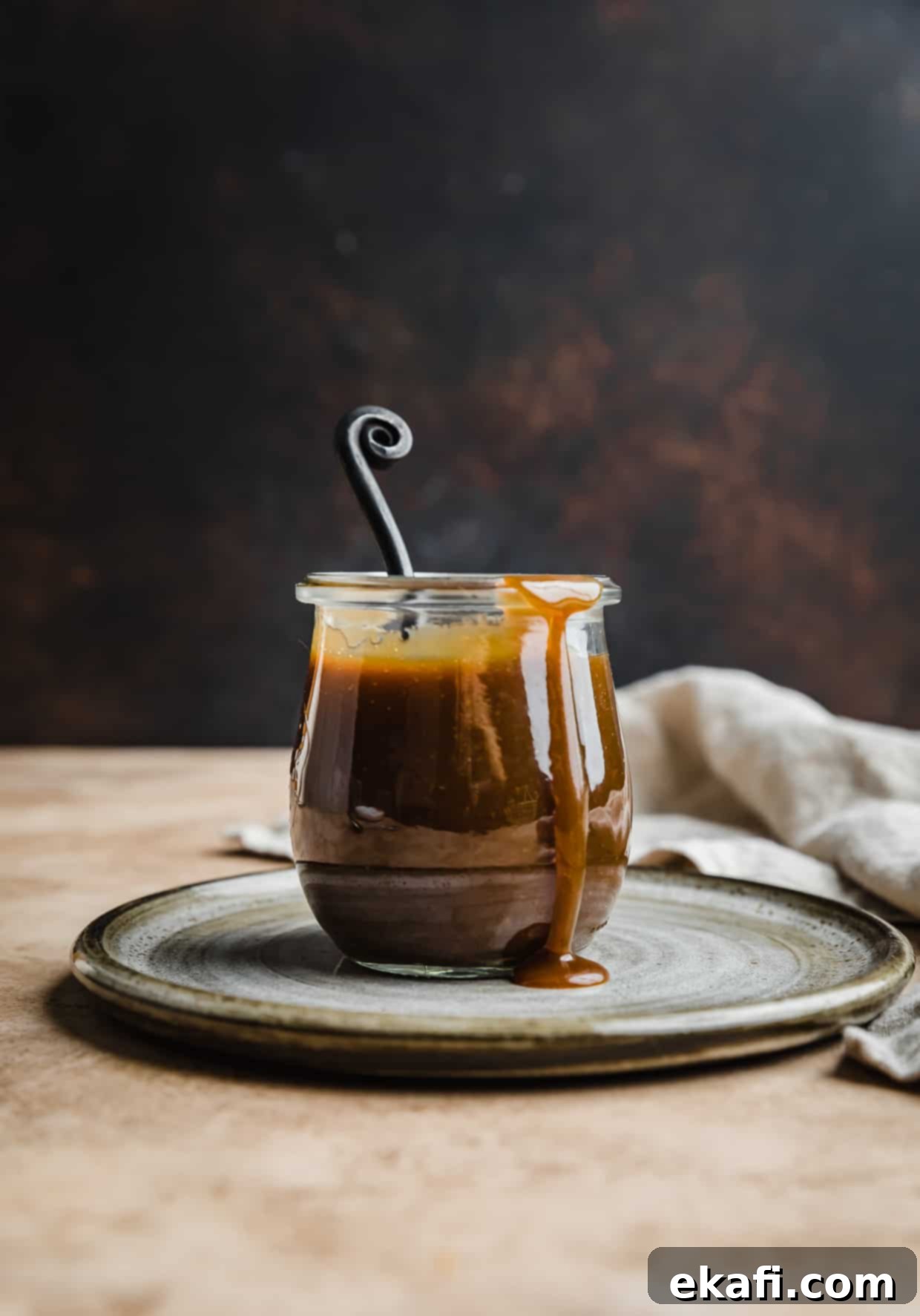
Explore More Decadent Sweet Sauces
If you’re a fan of luscious toppings and dips, be sure to check out these other fantastic sweet sauce recipes:
- Bright & Tangy Raspberry Sauce
- Classic Old Fashioned Hot Fudge Sauce
- The Best Caramel Apple Dip
Did you make this incredible salted butterscotch sauce? I’d absolutely love to hear about your experience! Leave a star rating and review below, or scroll to the recipe card to share your feedback. Your thoughts and creations inspire me!
Stay connected and up-to-date with all our latest recipes and tips by following us on Instagram, TikTok, Facebook, and Pinterest.
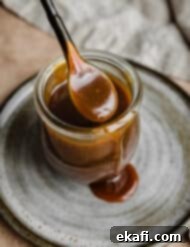
Print
SaveSaved!
Review
Salted Butterscotch Sauce
2 minutes
10 minutes
12 minutes
1 cup
Prevent your screen from going dark
Ingredients
- 4 tablespoons unsalted butter
- 1/2 cup brown sugar – packed, can be light or dark brown sugar (dark brown sugar recommended for richer flavor)
- 1/2 teaspoon kosher salt
- 1/2 cup heavy cream
- 1 teaspoon vanilla extract
Instructions
-
Add the butter to a medium saucepan set over medium heat. Melt the butter completely, then add the brown sugar, kosher salt, and heavy cream. Stir the mixture with a rubber spatula or wooden spoon until all ingredients are well combined.
-
Bring the butterscotch mixture to a gentle boil and continue to boil for 4-5 minutes, stirring occasionally to prevent sticking.
-
Remove the pan from the heat and stir in the vanilla extract until fully incorporated.
-
Let the sauce rest for a minute or two, then transfer it to a heat-proof container to cool. The mixture will thicken considerably as it cools, so avoid over-boiling. Cover and store in the fridge for up to 2 weeks.
Notes
Do not overcook the sauce; it thickens significantly as it cools. Boil only for the recommended 4-5 minutes to ensure a pourable consistency.
Maintain a moderate heat throughout the cooking process to prevent the sugar from burning, which can lead to a bitter taste.
This versatile butterscotch sauce is perfect with brownies, ice cream, peach cobbler, or blended into a delicious milkshake. Enjoy!
Nutrition
Whitney Wright
Dessert
American, English
